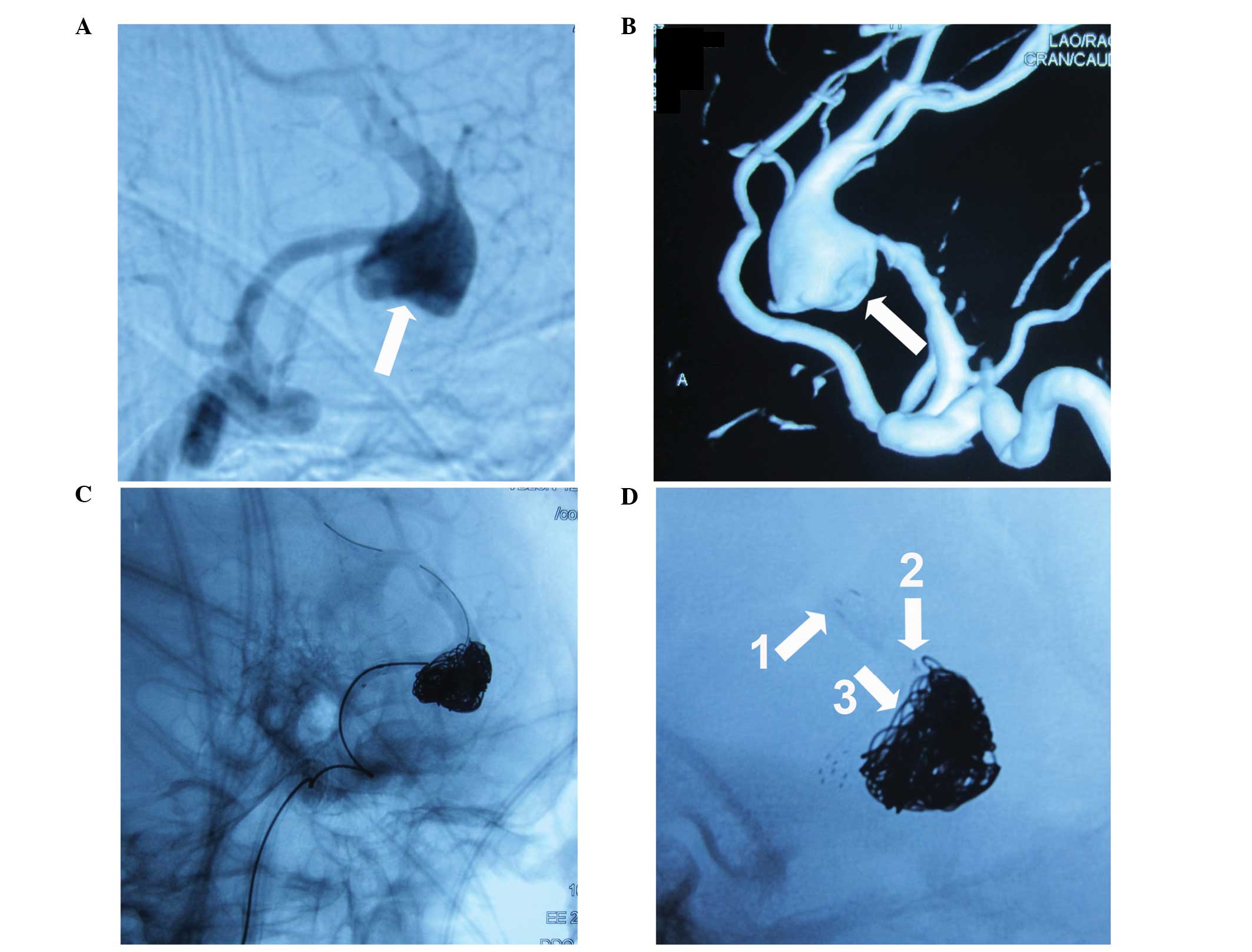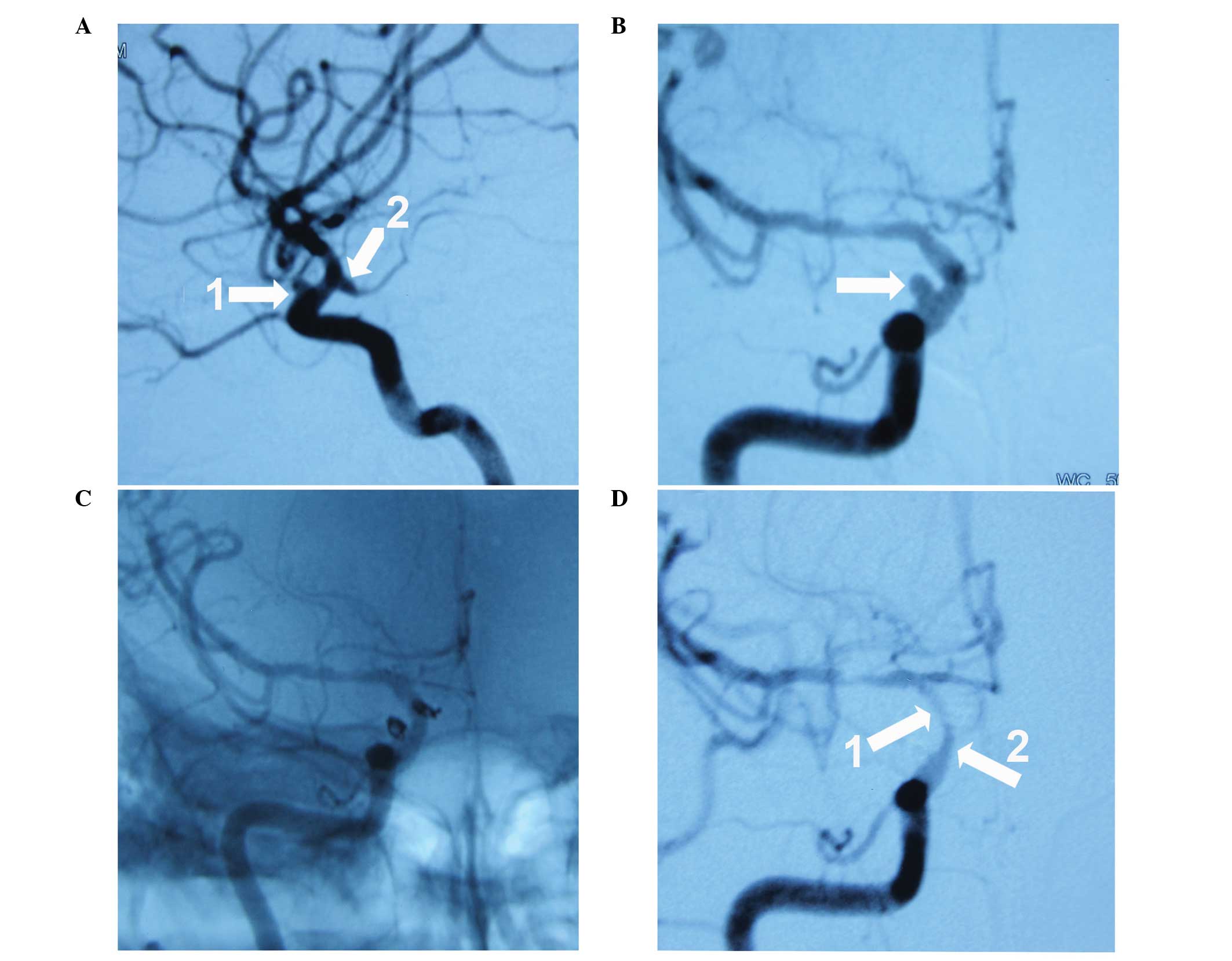|
1
|
Lubicz B, Balériaux D, Lefranc F, et al:
Endovascular treatment of intracranial aneurysms as the first
therapeutic option. J Neuroradiol. 34:250–259. 2007. View Article : Google Scholar : PubMed/NCBI
|
|
2
|
Moret J, Cognard C, Weill A, Castaings L
and Rey A: Reconstruction technic in the treatment of wide-neck
intracranial aneurysms. Long-term angiographic and clinical
results. Apropos of 56 cases. J Neuroradiol. 24:30–44. 1997.(In
French). PubMed/NCBI
|
|
3
|
Cloft HJ, Joseph GJ, Tong FC, Goldstein JH
and Dion JE: Use of three-dimensional Guglielmi detachable coils in
the treatment of wide-necked cerebral aneurysms. AJNR Am J
Neuroradiol. 21:1312–1314. 2000.PubMed/NCBI
|
|
4
|
Molyneux AJ, Cekirge S, Saatci I and Gál
G: Cerebral Aneurysm Multicenter European Onyx (CAMEO) trial:
results of a prospective observational study in 20 European
centers. AJNR Am J Neuroradiol. 25:39–51. 2004.PubMed/NCBI
|
|
5
|
Mocco J, Snyder KV, Albuquerque FC, et al:
Treatment of intracranial aneurysms with the Enterprise stent: a
multicenter registry. J Neurosurg. 110:35–39. 2009. View Article : Google Scholar : PubMed/NCBI
|
|
6
|
Liebig T, Henkes H, Reinartz J,
Miloslavski E and Kühne D: A novel self-expanding fully retrievable
intracranial stent (SOLO): experience in nine procedures of
stent-assisted aneurysm coil occlusion. Neuroradiology. 48:471–478.
2006. View Article : Google Scholar : PubMed/NCBI
|
|
7
|
Piotin M, Blanc R, Spelle L, et al:
Stent-assisted coiling of intracranial aneurysms: clinical and
angiographic results in 216 consecutive aneurysms. Stroke.
41:110–115. 2010. View Article : Google Scholar : PubMed/NCBI
|
|
8
|
Clajus C, Sychra V, Strasilla C and Klisch
J: Stent-assisted coil embolization of intracranial aneurysms using
the Solitaire™ AB Neurovascular Remodeling Device: initial and
midterm follow-up results. Neuroradiology. 55:629–638. 2013.
View Article : Google Scholar : PubMed/NCBI
|
|
9
|
Zhang X, Long XA, Luo B, Karuna T and Duan
CZ: Factors responsible for poor outcome after intraprocedural
rerupture of ruptured intracranial aneurysms: identification of
risk factors, prevention and management on 18 cases. Eur J Radiol.
81:e77–e85. 2012. View Article : Google Scholar : PubMed/NCBI
|
|
10
|
Raymond J, Guilbert F, Weill A, et al:
Long-term angiographic recurrences after selective endovascular
treatment of aneurysms with detachable coils. Stroke. 34:1398–1403.
2003. View Article : Google Scholar : PubMed/NCBI
|
|
11
|
Kadkhodayan Y, Rhodes N, Blackburn S, et
al: Comparison of Enterprise with Neuroform stent-assisted coiling
of intracranial aneurysms. AJR Am J Roentgenol. 200:872–878. 2013.
View Article : Google Scholar : PubMed/NCBI
|
|
12
|
Wang H, Xu D, Xiang Y, et al: Endovascular
treatment for wide-necked intracranial aneurysms with the
Enterprise stent. Neurol India. 59:548–552. 2011. View Article : Google Scholar : PubMed/NCBI
|
|
13
|
Lubicz B, Collignon L, Raphaeli G, et al:
Solitaire stent for endovascular treatment of intracranial
aneurysms: immediate and mid-term results in 15 patients with 17
aneurysms. J Neuroradiol. 37:83–88. 2010. View Article : Google Scholar : PubMed/NCBI
|
|
14
|
Zhao KJ, Zhang YW, Xu Y, et al:
Reconstruction of saccular and dissected intracranial aneurysms
using Solitaire™ AB stents. PLoS One. 8:e572532013. View Article : Google Scholar : PubMed/NCBI
|
|
15
|
Gao B and Malek AM: Possible mechanisms
for delayed migration of the closed cell - designed enterprise
stent when used in the adjunctive treatment of a basilar artery
aneurysm. AJNR Am J Neuroradiol. 31:E85–E86. 2010. View Article : Google Scholar : PubMed/NCBI
|
|
16
|
Heller RS and Malek AM: Delivery technique
plays an important role in determining vessel wall apposition of
the Enterprise self-expanding intracranial stent. J Neurointerv
Surg. 3:340–343. 2011. View Article : Google Scholar : PubMed/NCBI
|
|
17
|
Krischek O, Miloslavski E, Fischer S,
Shrivastava S and Henkes H: A comparison of functional and physical
properties of self-expanding intracranial stents [Neuroform3,
Wingspan, Solitaire, Leo+, Enterprise]. Minim Invasive Neurosurg.
54:21–28. 2011. View Article : Google Scholar : PubMed/NCBI
|
|
18
|
Yahia AM, Gordon V, Whapham J, et al:
Complications of Neuroform stent in endovascular treatment of
intracranial aneurysms. Neurocrit Care. 8:19–30. 2008. View Article : Google Scholar : PubMed/NCBI
|
|
19
|
Izar B, Rai A, Raghuram K, Rotruck J and
Carpenter J: Comparison of devices used for stent-assisted coiling
of intracranial aneurysms. PLoS One. 6:e248752011. View Article : Google Scholar : PubMed/NCBI
|
|
20
|
Lv X, Li Y, Xinjian Y, Jiang C and Wu Z:
Results of endovascular treatment for intracranial wide-necked
saccular and dissecting aneurysms using the Enterprise stent: a
single center experience. Eur J Radiol. 81:1179–1183. 2012.
View Article : Google Scholar : PubMed/NCBI
|
|
21
|
Colby GP, Paul AR, Radvany MG, et al: A
single center comparison of coiling versus stent assisted coiling
in 90 consecutive paraophthalmic region aneurysms. J Neurointerv
Surg. 4:116–120. 2012. View Article : Google Scholar : PubMed/NCBI
|
|
22
|
Gu DQ, Zhang X, Luo B, Long XA and Duan
CZ: The effect of Neuroform stent-assisted coil embolization of
wide-necked intracranial aneurysms and clinical factors on
progressive aneurysm occlusion on angiographic follow-up. J Clin
Neurosci. 20:244–247. 2013. View Article : Google Scholar : PubMed/NCBI
|
|
23
|
Mangiafico S, Guarnieri G, Consoli A,
Ambrosanio G and Muto M: Endovascular strategy for unruptured
cerebral aneurysms. Eur J Radiol. 82:1638–1645. 2013. View Article : Google Scholar : PubMed/NCBI
|
|
24
|
Pereira VM, Brina O, Gonzalez AM, et al:
Biology and hemodynamics of aneurismal vasculopathies. Eur J
Radiol. 82:1606–1617. 2013. View Article : Google Scholar : PubMed/NCBI
|
|
25
|
Lubicz B, Bandeira A, Bruneau M, et al:
Stenting is improving and stabilizing anatomical results of coiled
intracranial aneurysms. Neuroradiology. 51:419–425. 2009.
View Article : Google Scholar : PubMed/NCBI
|
|
26
|
Weber W, Bendszus M, Kis B, et al: A new
self-expanding nitinol stent (Enterprise) for the treatment of
wide-necked intracranial aneurysms: initial clinical and
angiographic results in 31 aneurysms. Neuroradiology. 49:555–561.
2007. View Article : Google Scholar : PubMed/NCBI
|
|
27
|
Lee JI, Ko JK, Choi BK and Choi CH:
In-stent stenosis of stent-assisted coil embolization of the
supraclinoid internal carotid artery aneurysm. J Korean Neurosurg
Soc. 51:370–373. 2012. View Article : Google Scholar : PubMed/NCBI
|













